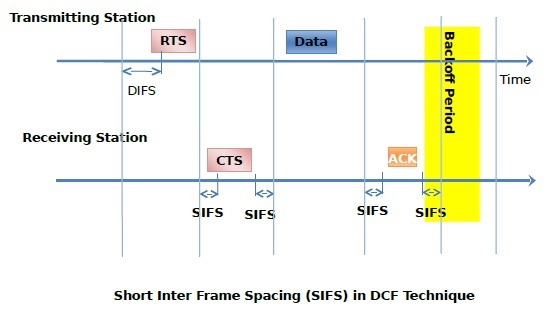
 Data Structure
Data Structure Networking
Networking RDBMS
RDBMS Operating System
Operating System Java
Java MS Excel
MS Excel iOS
iOS HTML
HTML CSS
CSS Android
Android Python
Python C Programming
C Programming C++
C++ C#
C# MongoDB
MongoDB MySQL
MySQL Javascript
Javascript PHP
PHP
- Selected Reading
- UPSC IAS Exams Notes
- Developer's Best Practices
- Questions and Answers
- Effective Resume Writing
- HR Interview Questions
- Computer Glossary
- Who is Who
Short InterFrame Spacing (DIFS)
Short Interframe Spacing (SIFS), is the time interval required by a wireless device in between receiving a frame and responding to the frame. It is used in Distributed coordination function (DCF) scheme, which is a mandatory technique used to prevent collisions in IEEE 802.11-based WLAN standard (Wi-Fi).
The duration of SIFS is equal to the sum of delays in radio frequency (RF), Physical Layer Convergence Procedure (PLCP) and processing delay of MAC (medium access control) layer.
In IEEE 802.11 networks, SIFS is the interframe spacing maintained before and after the transmission of an acknowledgment frame and Clear To Send (CTS) frame.
Technique
The role of SIFS can be understood from the transmission procedure in DCF scheme which is outlined as follows −
- When a station has a frame to transmit, it waits for a random backoff time. At the end of the backoff period, if the channel is clear, the station will wait for an amount of time equal to DCF Inter Frame Spacing and sense the channel again.
- If the channel is still clear, the transmitting station transmits a RTS (request to send) frame.
- On receiving the RTS frame, the destination station waits for a SIFS time interval and then responds using a CTS (clear to send) frame. After sending the CTS frame it again waits for another SIFS before it is ready to accept data frames.
- Then the transmitting station sends the data frames.
- After the frames are sent, the transmitting station waits for a time equal to SIFS (Short Inter-Frame Space) for the acknowledgement (ACK).
- After sending the ACK frame, the receiving station waits for another SIFS, before restarting the whole procedure.
The technique is shown in the following diagram −


